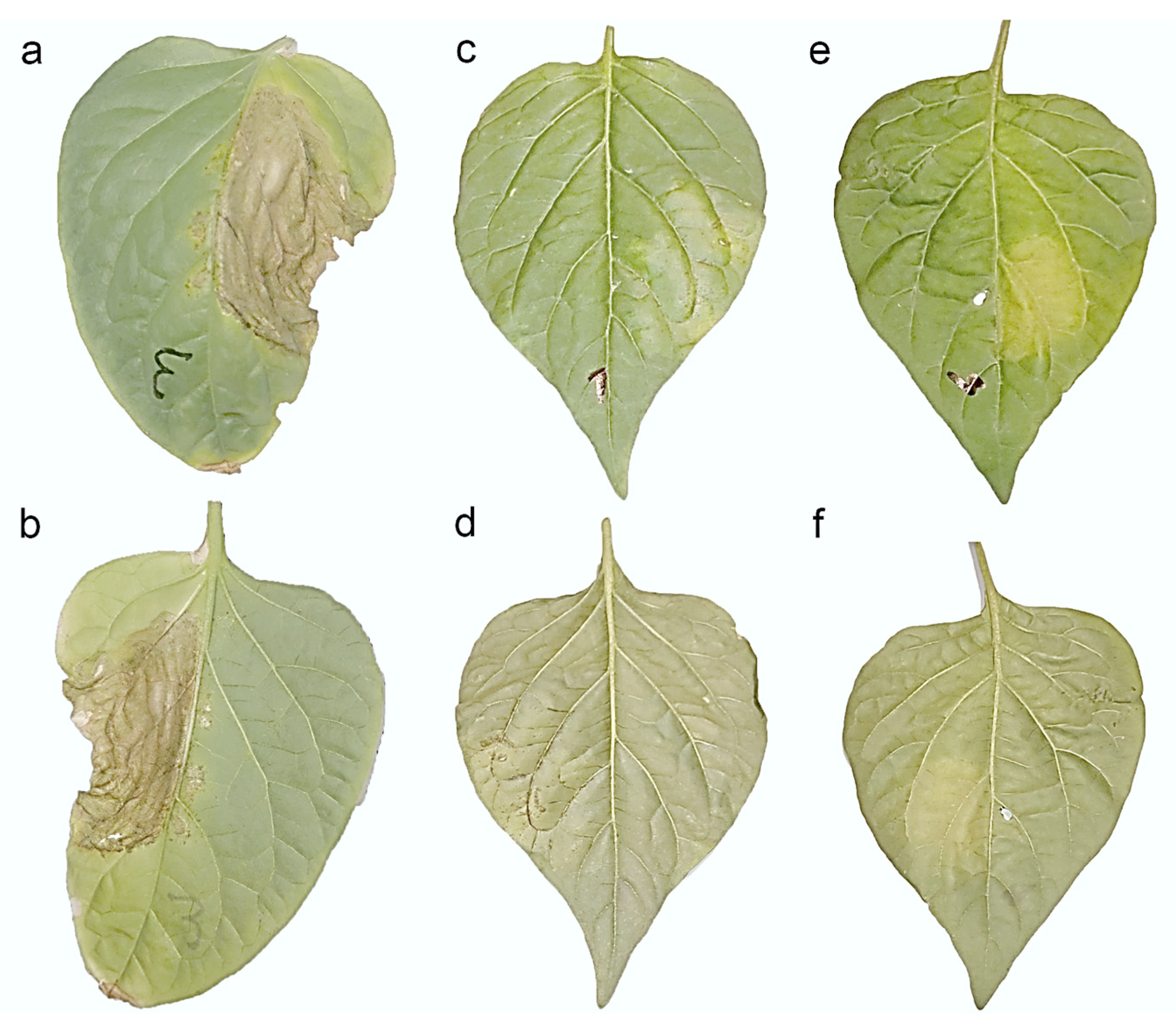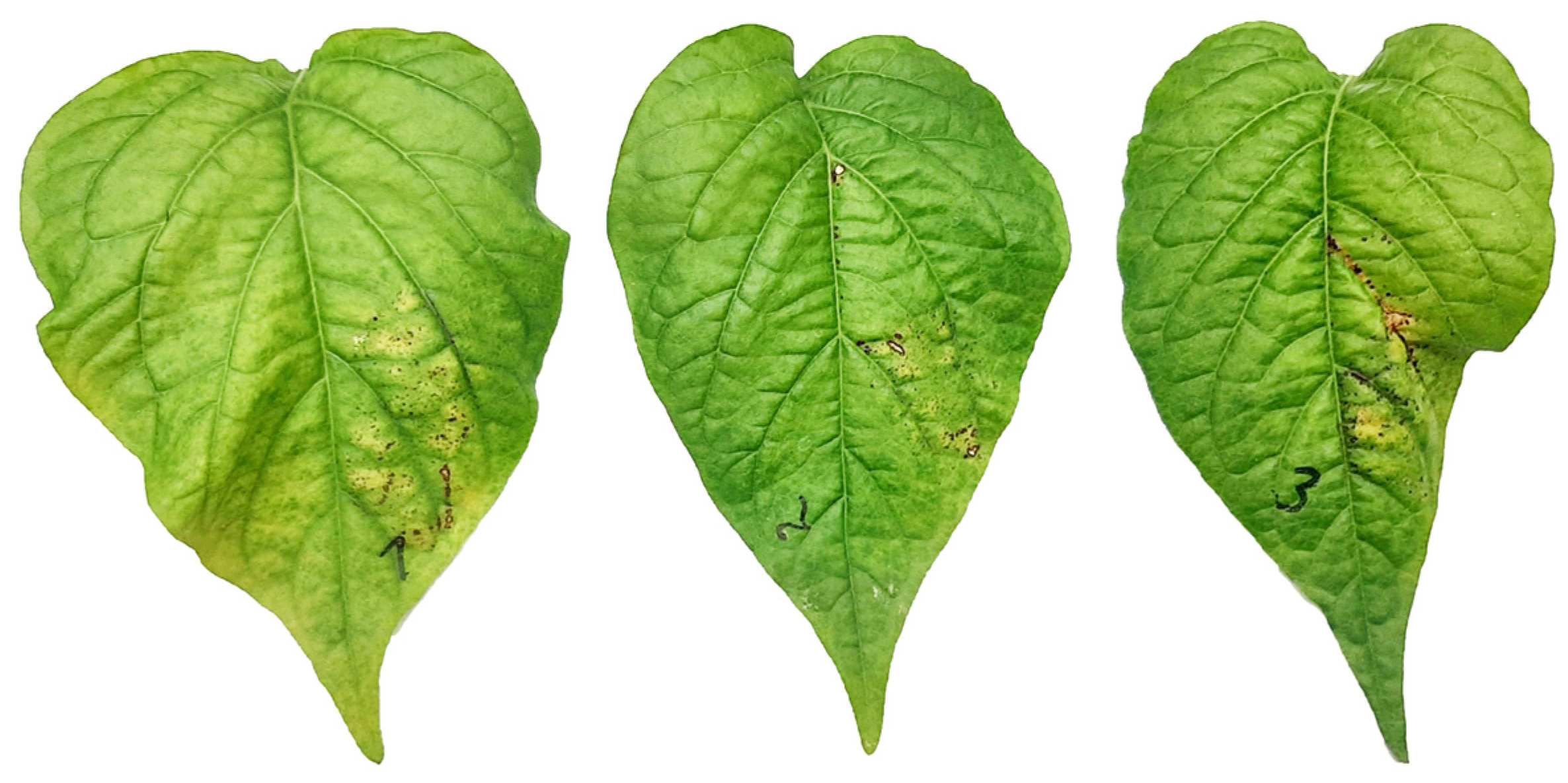Screening Wild Pepper Germplasm for Resistance to Xanthomonas hortorum pv. gardneri
Abstract
1. Introduction
2. Materials and Methods
2.1. Plant Materials
2.2. Bacterial Isolates and Plant Infiltration
2.3. Bacterial Growth Test
3. Results
3.1. Evaluation of C. baccatum Accessions for the Susceptibility and Resistance to X. hortorum pv. gardneri
3.2. Evaluation of the Bacterial Growth Test
4. Discussion
5. Conclusions
Supplementary Materials
Author Contributions
Funding
Institutional Review Board Statement
Informed Consent Statement
Data Availability Statement
Conflicts of Interest
References
- FAOSTAT, Food and Agriculture Organization (FAO). 2021. Available online: http://www.fao.org/faostat/en/#home (accessed on 15 April 2021).
- Barboza, G.E.; García, C.C.; Scaldaferro, M.; Bohs, L. An amazing new Capsicum (Solanaceae) species from the Andean-Amazonian Piedmont. PhytoKeys 2020, 167, 13–29. [Google Scholar] [CrossRef] [PubMed]
- USDA, ARS, National Genetic Resources Program. Germplasm Resources Information Network (GRIN). National Germplasm Resources Laboratory, Beltsville, Maryland. Available online: http://www.arsgrin.gov/cgi-bin/npgs/html/exsplist.pl (accessed on 23 May 2015).
- Mundt, C.C. Durable resistance: A key to sustainable management of pathogens and pests. Infect. Genet. Evol. 2014, 27, 446–455. [Google Scholar] [CrossRef] [PubMed]
- Collinge, D.B.; Sarrocco, S. Transgenic approaches for plant disease control: Status and prospects. Plant Pathol. 2022, 71, 207–225. [Google Scholar] [CrossRef]
- Jones, J.B.; Lacy, G.H.; Bouzar, H.; Stall, R.E.; Schaad, N.W. Reclassification of the xanthomonads associated with bacterial spot disease of tomato and pepper. Syst. Appl. Microbiol. 2004, 27, 755–762. [Google Scholar] [CrossRef]
- Šutic, D. Bakterioze crvenog patlidzana (Tomato bacteriosis). Rev. Appl. Mycol. 1957, 36, 734–735. [Google Scholar]
- Khanal, S.; Hind, S.R.; Babadoost, M. Occurrence of Copper-Resistant Xanthomonas perforans and X. gardneri in Illinois Tomato Fields. Plant Health Prog. 2020, 21, 338–344. [Google Scholar] [CrossRef]
- El-Fiki, I.A.I.; Youssef, M.; Eman, H.O. Controlling The Bacterial Leaf Spot Disease in Pepper Caused by Xanthomonas vesicatoria Using Natural Bacteritoxicants. Egypt. Acad. J. Biol. Sci. F. Toxicol. Pest Control. 2022, 14, 229–245. [Google Scholar] [CrossRef]
- Stall, R.E.; Jones, J.B.; Minsavage, G.V. Durability of resistance in tomato and pepper to xanthomonads causing bacterial spot. Annu. Rev. Phytopathol. 2009, 47, 265–284. [Google Scholar] [CrossRef]
- Yang, W.C.; Sacks, E.J.; Ivey, M.L.L.; Miller, S.A.; Francis, D.M. Resistance in Lycopersicon esculentum intraspecific crosses to race T1 strains of Xanthomonas campestris pv. vesicatoria causing bacterial spot of tomato. Phytopathology 2005, 95, 519–527. [Google Scholar] [CrossRef]
- Wang, H.; Hutton, S.F.; Robbins, M.D.; Sim, S.C.; Scott, J.W.; Yang, W.; Jones, J.B.; Francis, D.M. Molecular mapping of hypersensitive resistance from tomato ‘Hawaii 7981’ to Xanthomonas perforans race T3. Phytopathology 2011, 101, 1217–1223. [Google Scholar] [CrossRef][Green Version]
- Sharlach, M.; Dahlbeck, D.; Liu, L.; Chiu, J.; Jiménez-Gómez, J.M.; Kimura, S.; Koenig, D.; Maloof, J.N.; Sinha, N.; Minsavage, G.V.; et al. Fine genetic mapping of RXopJ4, a bacterial spot disease resistance locus from Solanum pennellii LA716. Theor. Appl. Genet. 2013, 126, 601–609. [Google Scholar] [CrossRef] [PubMed]
- Scott, J.W.; Francis, D.M.; Miller, S.A.; Somodi, G.C.; Jones, J.B. Tomato bacterial spot resistance derived from PI 114490; inheritance to race T2 and relationship across three pathogen races. J. Am. Soc. Hortic. Sci. 2003, 128, 698–703. [Google Scholar] [CrossRef]
- Potnis, N.; Krasileva, K.; Chow, V.; Almeida, N.F.; Patil, P.B.; Ryan, R.P.; Sharlach, M.; Behlau, F.; Dow, J.M.; Momol, M.T.; et al. Comparative genomics reveals diversity among xanthomonads infecting tomato and pepper. BMC Genom. 2011, 12, 146. [Google Scholar] [CrossRef]
- Potnis, N.; Timilsina, S.; Strayer, A.; Shantharaj, D.; Barak, J.D.; Paret, M.L.; Vallad, G.E.; Jones, J.B. Bacterial spot of tomato and pepper: Diverse Xanthomonas species with a wide variety of virulence factors posing a worldwide challenge. Mol. Plant Pathol. 2015, 16, 907–920. [Google Scholar] [CrossRef] [PubMed]
- Potnis, N.; Branham, S.E.; Jones, J.B.; Wechter, W.P. Genome-Wide Association Study of Resistance to Xanthomonas gardneri in the USDA Pepper (Capsicum) Collection. Phytopathology 2019, 109, 1217–1225. [Google Scholar] [CrossRef] [PubMed]
- Sharma, A.; Minsavage, G.V.; Gill, U.S.; Hutton, S.F.; Jones, J.B. Identification and Mapping of bs8, a Novel Locus Conferring Resistance to Bacterial Spot Caused by Xanthomonas gardneri. Phytopathology 2022, 112, 1640–1650. [Google Scholar] [CrossRef]
- Murashige, T.; Skoog, F. A Revised Medium for Rapid Growth and Bio Assays with Tobacco Tissue Cultures. Physiol. Plant. 1962, 15, 473–497. [Google Scholar] [CrossRef]
- Schaad, N.W. Laboratory Guide for the Identification of Plant Pathogenic Bacteria; The American Phytopathological Society: St. Paul, MN, USA, 1988; pp. 81–82. [Google Scholar]
- Dewitt, D.; Bosland, P.W. The Complete Chile Pepper Book—A Gardener ’s Guide to Choosing, Growing, Preserving and Cooking; Timber Press: Portland, OR, USA, 2009; p. 336. [Google Scholar]
- Moscone, E.A.; Scaldaferro, M.A.; Grabiele, M.; Cecchini, N.M.; García, Y.S.; Jarret, R.; Daviña, J.R.; Ducasse, D.A.; Barboza, G.E.; Ehrendorfer, F. The evolution of chili peppers (Capsicum-Solanaceae): A cytogenetic perspective. Acta Hortic. 2007, 745, 137–169. [Google Scholar] [CrossRef]
- Cardoso, R.; Ruas, C.F.; Giacomin, R.M.; Ruas, P.M.; Ruas, E.A.; Barbieri, R.L.; Rodrigues, R.; Gonçalves, L.S.A. Genetic variability in Brazilian Capsicum baccatum germplasm collection assessed by morphological fruit traits and AFLP markers. PLoS ONE 2018, 13, e0196468. [Google Scholar] [CrossRef]
- Horvath, D.M.; Stall, R.E.; Jones, J.B.; Pauly, M.H.; Vallad, G.E.; Dahlbeck, D.; Staskawicz, B.J.; Scott, J.W. Transgenic resistance confers effective field level control of bacterial spot disease in tomato. PLoS ONE 2012, 7, e42036. [Google Scholar] [CrossRef]
- Gassmann, W.; Dahlbeck, D.; Cjesnokova, O.; Minsavage, G.V.; Jones, J.B.; Staskawicz, B.J. Molecular evolution of virulence in natural field strains of Xanthomonas campestris pv. vesicatoria. J. Bacteriol. 2000, 182, 7053–7059. [Google Scholar] [CrossRef] [PubMed]
- Manzur, J.P.; Fita, A.; Prohens, J.; Rodríguez-Burruezo, A. Successful Wide Hybridization and Introgression Breeding in a Diverse Set of Common Peppers (Capsicum annuum) Using Different Cultivated Ají (C. baccatum) Accessions as Donor Parents. PLoS ONE 2015, 10, e0144142. [Google Scholar] [CrossRef] [PubMed]
- Potnis, N.; Minsavage, G.; Smith, J.K.; Hurlbert, J.C.; Norman, D.; Rodrigues, R.; Stall, R.E.; Jones, J.B. Avirulence proteins AvrBs7 from Xanthomonas gardneri and AvrBs1.1 from Xanthomonas euvesicatoria contribute to a novel gene-for-gene interaction in pepper. Mol. Plant-Microbe Interact. 2012, 25, 307–320. [Google Scholar] [CrossRef] [PubMed][Green Version]




| Species | Strain Name | Origin | Host Isolated | Year Isolated | Isolation ID | Collector |
|---|---|---|---|---|---|---|
| X. hortorum pv. gardneri | LMG962 | Republic of Yugoslavia | tomato | 1957 | - | Sutic D. |
| SRB | Republic of Yugoslavia | tomato | 1957 | - | Sutic D. | |
| Xg51 | - 1 | - | - | - | T. Minsavage | |
| Xg152 | - | - | - | - | - | |
| Xg153 | Gibsonburg, OH | tomato | 2010 | SM194-10 | S. Miller | |
| Xg156 | Blissfield, MI | tomato | 2010 | SM177-10 | S. Miller | |
| Xg177 | Sandusky Co., OH | tomato | 2012 | SM795-12 | S. Miller |
| Species | Variety | Accession | SRB | LMG962 | XG51 | XG152 | XG153 | XG156 | XG177 |
|---|---|---|---|---|---|---|---|---|---|
| C.baccatum | pendulum | Cbp1 | + | + | + | + | + | + | + |
| Cbp2 | + | + | + | + | + | + | + | ||
| Cbp3 | + | + | + | + | + | + | + | ||
| Cbp4 | + | + | + | + | + | + | + | ||
| PI 441541 | + | − | |||||||
| PI 441542 | + | − | |||||||
| PI 370010 | − | + | |||||||
| PI 441543 | + | - | |||||||
| PI 441578 | + | − | |||||||
| PI 441552 | − | + | |||||||
| PI 441533 | − | + | |||||||
| PI 441520 | + | − |
Disclaimer/Publisher’s Note: The statements, opinions and data contained in all publications are solely those of the individual author(s) and contributor(s) and not of MDPI and/or the editor(s). MDPI and/or the editor(s) disclaim responsibility for any injury to people or property resulting from any ideas, methods, instructions or products referred to in the content. |
© 2023 by the authors. Licensee MDPI, Basel, Switzerland. This article is an open access article distributed under the terms and conditions of the Creative Commons Attribution (CC BY) license (https://creativecommons.org/licenses/by/4.0/).
Share and Cite
Tóth, Z.G.; Tóth, M.; Fekete, S.; Szabó, Z.; Tóth, Z. Screening Wild Pepper Germplasm for Resistance to Xanthomonas hortorum pv. gardneri. Sustainability 2023, 15, 908. https://doi.org/10.3390/su15020908
Tóth ZG, Tóth M, Fekete S, Szabó Z, Tóth Z. Screening Wild Pepper Germplasm for Resistance to Xanthomonas hortorum pv. gardneri. Sustainability. 2023; 15(2):908. https://doi.org/10.3390/su15020908
Chicago/Turabian StyleTóth, Zoltán Gábor, Máté Tóth, Sándor Fekete, Zoltán Szabó, and Zoltán Tóth. 2023. "Screening Wild Pepper Germplasm for Resistance to Xanthomonas hortorum pv. gardneri" Sustainability 15, no. 2: 908. https://doi.org/10.3390/su15020908
APA StyleTóth, Z. G., Tóth, M., Fekete, S., Szabó, Z., & Tóth, Z. (2023). Screening Wild Pepper Germplasm for Resistance to Xanthomonas hortorum pv. gardneri. Sustainability, 15(2), 908. https://doi.org/10.3390/su15020908






